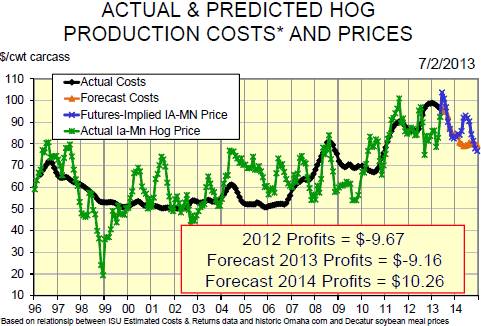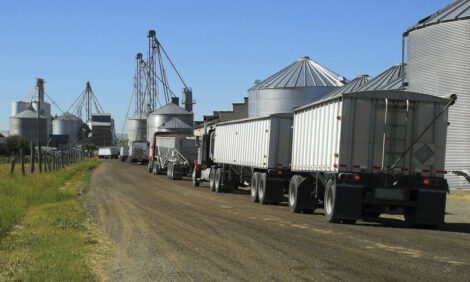



CME: Soybean Market Remains Constant
US - There has been a positive porcine epidemic diarrhea virus (PEDv) test in North Carolina. That development is significant in that it is a new part of the country for the virus and because hog populations are dense in eastern North Carolina, write Steve Meyer and Len Steiner.Whether it turns out to be significant for the spread of the disease remains to be seen as producers everywhere have ratcheted up biosecurity protocols and enforcement in an effort to stop the spread of the disease. One example: Sow purchases from North Carolina plunged last week, presumably due to producers not wanting to send trucks or trailers to buying stations and thus run the risk of transferring the disease back to the farm.
The National Animal Health Laboratory Network (HAHLN) has taken over the effort to track the PEDv situation from the American Association of Swine Veterinarians. The tally sheet for positive PEDv tests and their locations can still be found at www.aasv.org. This week’s release, which includes tests at veterinary diagnostic labs through 17 June, shows 47 new positive tests. NAHLN has changed the classification system from farm type (sow herds, grow-finish herds, etc.) to simply listing the type of animal that the sample came from whenever that is known. Of the 47 new positive tests, 7 were from suckling pigs and 11 were from sows or boars while five were from nursery pigs and 13 were from grow-finish pigs. Fourteen samples had no animal type notation. Of the 47 new cases, 22 were in Oklahoma, bringing the total for that state to 60, nearly one-fourth of the total 265 positive samples to date.
The situation in North Carolina will be closely watched. The disease still has the potential to impact market hog supplies this fall and winter but we reiterate that it has been found only about 250 of the 68,000-plus US hog "operations" as defined by USDA. Even if the impacted farms are large, the number of pigs impacted is still relatively small and the impacts are being spread over many weeks — pigs farrowed this week will not reach market weight until January 2014. We will continue to share confirmed, factual information about PEDv with DLR readers.
What did Friday’s Acreage and Grain Stocks reports mean to the livestock and poultry sectors? In a word: RELIEF. Now whether that relief is justified or not remains to be seen.
First the easy one. The Grain Stocks report (it’s been a while since this one we would have referred to this on as "easy"!) showed slightly smaller-than-expected 1 June stocks for corn, soybeans and wheat but the deviations were not nearly as large — especially for corn — as we have seen in recent stocks estimates. The news was more bullish for old crop soybeans and soybean meal simply due, in our opinion, to the tighter old crop supply situation for beans. That is especially true due to the timing of this and last year’s crops which has, in effect, lengthened the 2012-13 marketing year.
The more challenging report was the annual Acreage report that included a surprise in an estimated 97.4 million acres of corn. That is 100,000 more than the planting intentions back in March and 2.1 MILLION more than the average of analysts’ pre-report estimates.
USDA’s 89.1 million acre estimate for harvested corn acres implies a harvest rate of 91.5 per cent, significantly higher than last year’s 89.9 per cent but slightly lower than the 91.8 per cent average for 2007-2011. It’s still a reasonable harvest rate at present. Should that many acres be harvested and should they yield the latest USDA estimate of 156.5 bushels/acre, this crop would be a RECORD-LARGE 13.944 billion bushels.
The corn market is dealing with that prospect with new crop December falling by 37 cents since Thursday’s close. There hasn’t been a trade below $5.00 per bushel yet but when the market gets to $5.01, it can go under $5 by accident.
DLR author Steve Meyer did a windshield survey of crop conditions between Des Moines and Springfield, IL last week — at the exact same time that he made the same trip last year. The corn this year is, generally, half as tall and twice as green. The half as tall part is not really a problem since last year’s corn was, of course, far ahead of its normal pace at the end of June. This year’s crop looks good and ranged from thigh high in Iowa to waste high or better in central Illinois. Beans are all over the map with some just emerging in Iowa to some beans that were probably a foot tall (and looking quite good) in Illinois.
It is no accident that the soybean market hasn’t moved lower as the lateness of this crop leaves significant weather risk in play. The most notable, in our opinion, is the risk of an early frost. That factor was gone, of course, last year by this time. But it looms large in ’13.
Just how much "relief" has this provided the livestock industries? We use the pork industry as our example. As can be seen below, current corn and soybean meal futures imply costs of just over $80/cwt carcass for 2014. That figure is over $13/cwt — or roughly $26 per head! — lower than this year. Though Lean Hogs futures imply hog prices roughly $4.50/cwt lower next year, the decline in costs imply profits of just over $10/head — the best for an entire year since 2010.









